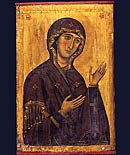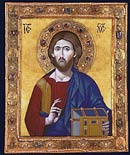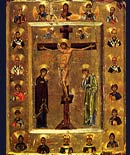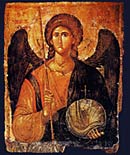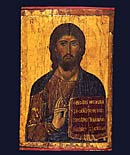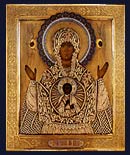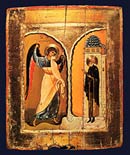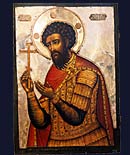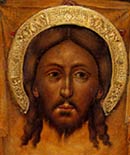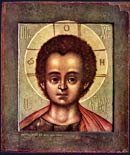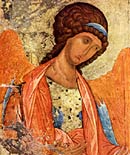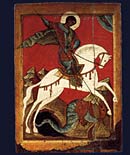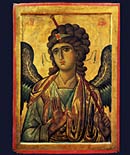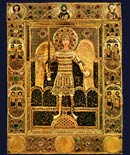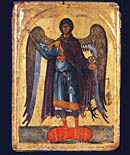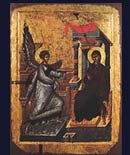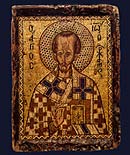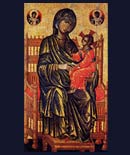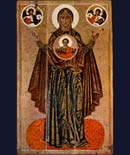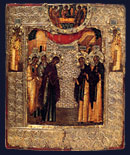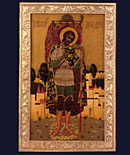How Ikons Are Created - Gilding & Varnishing
Gilding is, for me, the most difficult part of ikon painting and I approach it with great trepidation every time I do it. Gilding is completely unforgiving and difficult to correct if done wrong. The hardest thing is to create an all-over even effect.
There are a number of methods for gilding, which include painted gold, gold-leaf adhered by applied glues and water gilding on gesso. Of these The first is the easiest. Gilding is extremely hard to master and can be very frustrating - as well as expensive. There are two different kinds of real gold-leaf, which comes in packets of around 25-40 sheets. A 14 by 20 inch ikon will take one packet of gold leaf which costs around $35. One is called 'wind-blown', which is used in water and bole gilding; and 'patent' gold, which is used in gilding with size. The difference is that wind-blown gold-leaf is loosely set in its packet, so that a cat's hair brush can easily lift it from the folder onto the surface you are gilding; while pantent gold-leaf is attached to a removable piece of thin paper which is directly (and delicately) applied to a tacky sized surface. The gold-leaf is lightly rubbed through the paper until it has completely attached and then the paper is carefully removed. I recommend experimentation using a good book, such as 'The Art of Tempera Painting", which you can get from Sinopia, as a guide. I use 23kt patent gold-leaf and Japan Gold Size. It adheres fast but is tricky to use. I suggest using an artificial gold paint for your first ikon, a blue background and limiting the idea to be gilded to halos. This should only be step towards learning the proper methods. Water gilding is the best, because it allows the artist to polish the surface after the application of real gold leaf, creating a mirror-like surface.
There are also artificial gold-leaf packets which are less expensive than genuine gold. They only seem to come in the wind-blown variety.
Varnishing
When the painting has been completed it should be allowed to dry out completely. I suggest a week or more. A final varnish is necessary to protect the surface of the ikon. Do not use normal painting varnish. Russian painters used a refined oil to coat their ikons. This was a bad choice, as the oil soaked up dirt and grime. This is the reason many ancient Russian ikons have been repainted many times. The best varnish is shellac, which is a natural substance made from trees. I always use a spray shellac, putting on a number of light gentle coats. Make sure the temperature where you are applying the shellac is above 65F, free of any sudden gusts of air, insects and pet or human hair. There is nothing worse than to find a fly which has mistakenly alighted on your painting embedded in the shellac. As I mentioned earlier, always use light coats and let each layer dry. Putting the shellac on in too thick layers can cause cloudiness.
Request a quote on a painting seen on this page or a new commission from Bob Atchison, click here.
